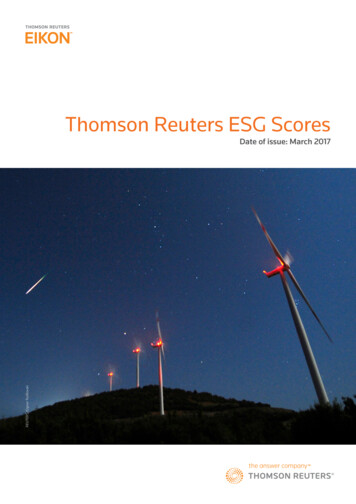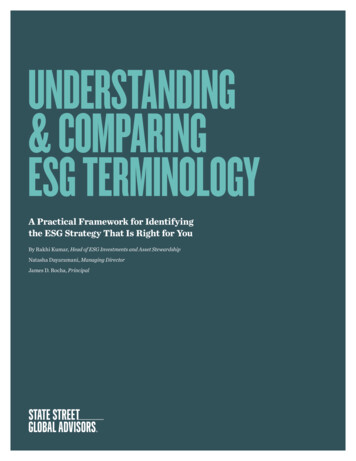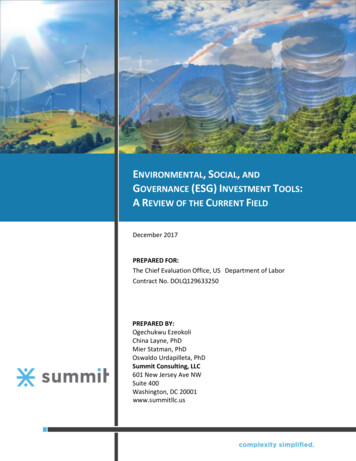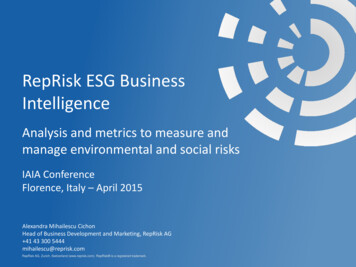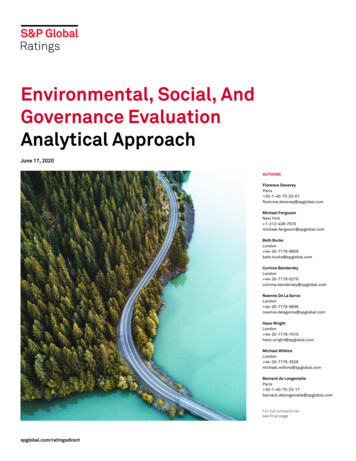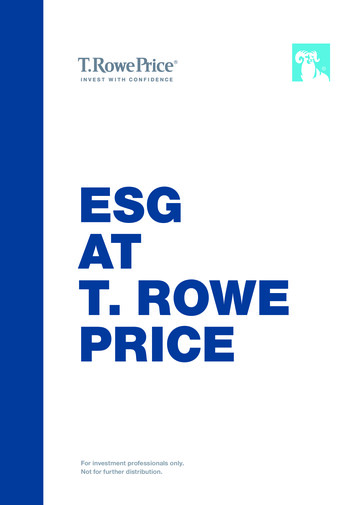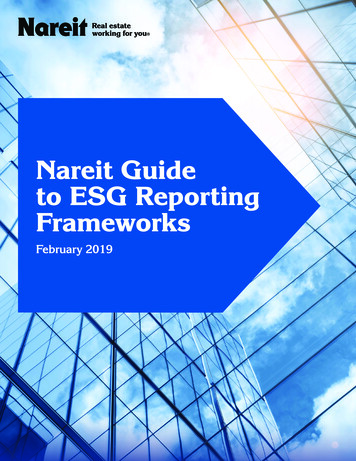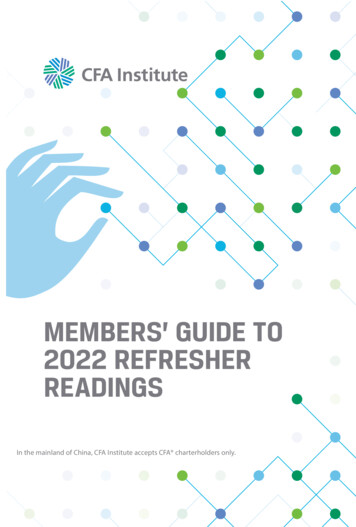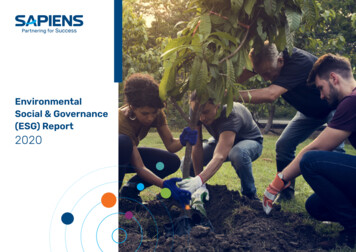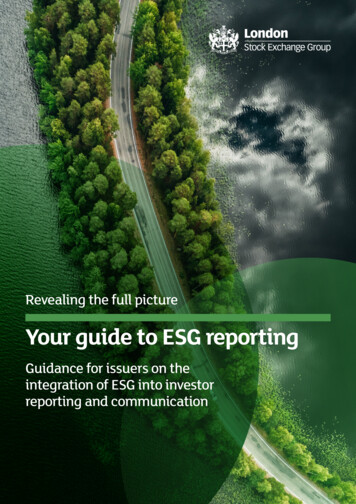
Transcription
Revealing the full pictureYour guide to ESG reportingGuidance for issuers on theintegration of ESG into investorreporting and communication
ContentsThis Guidance is for information only. It has been produced by London StockExchange Group plc and its group companies, including London Stock Exchangeplc, FTSE Russell (a trading name of FTSE International Limited and Frank RussellCompany) and Borsa Italiana S.p.A (LSEG). While all information contained herein isobtained from sources believed to be accurate and reliable, LSEG and the individualauthors of the Guidance do not accept responsibility for any errors, omissions,or inaccurate information or any decisions made in reliance on this Guidance.Any inaccuracies can be reported in writing to sustainablebusiness@lseg.combut neither LSEG nor the individual authors of the Guidance shall becomeresponsible for such inaccuracies as a result of them being reported.This publication does not constitute an offer to buy or sell, or a solicitation ofan offer to sell, any securities, or the solicitation of a proxy, by any person in anyjurisdiction in which such an offer or solicitation is not authorised, or in which theperson making such an offer or solicitation is not qualified to do so, or to anyperson to whom it is unlawful to make such an offer or solicitation.This Guidance is not offered as advice on any particular matter and must notbe treated as a substitute for specific advice. In particular, information in thispublication does not constitute legal, professional, financial or investment adviceor an endorsement of any particular reporting standard or framework in relationto Environmental, Social and Governmental (ESG) factors. Advice from a suitablyqualified professional should always be sought in relation to any particularmatter or circumstances.“FTSE ”, “Russell ”, “FTSE Russell ”, “London Stock Exchange ”, “London StockExchange Group ” and other related service marks and trademarks are trademarksof the London Stock Exchange group companies. No part of these trade marksor any other trade mark owned by the London Stock Exchange or any of its groupundertakings can be used, reproduced or transmitted in any form withoutexpress written consent by the owner of the trade mark. 2020Introduction2Towards deeper understanding between issuers and investors4ESG reporting priorities601. Strategic relevance802. Investor materiality1203. Investment grade data1804. Global frameworks2205. Reporting formats2806. Regulation and investor communication3207. Green Revenue reporting3608. Debt finance40Summary46How LSEG supports ESG reporting and communication47Appendices48
2Revealing the full pictureIntroduction3IntroductionOnce upon a time, environmental, social and governance(ESG) factors were a niche interest among asset owners, assetmanagers, banks, brokers and investment consultants. No longer.Investors now routinely analyse information on ESG performancealongside other financial and strategic information in order togain a better understanding of companies’ future prospects.Issuers’ ESG performance on subjects such as resourceuse, human rights, health and safety, corruption andtransparency is increasingly used to draw conclusionsabout the quality of their management, identify theirexposure to business risks and assess their ability toleverage business opportunities. Therefore it is becomingmore and more important for companies and otherissuers to communicate with investors clearly andaccurately on these aspects of their performance.The intention of this Guidance is to help companiesgain a clear understanding of what ESG informationthey should provide and how they should go aboutproviding it. This is a task for which London StockExchange Group, as a leading international marketsinfrastructure provider connected to issuers, sell sideand investors is ideally placed.About London StockExchange GroupSitting at a critical junction between issuers andinvestors, London Stock Exchange Group plays anessential role in supporting global sustainableeconomic growth.With more than 2,700 companies hosted on ourmarkets, we seek to recognise and encourage dynamiccompanies that will drive long-term economicprosperity; helping them improve the sustainability oftheir business and enhance their ability to raise capitalfor growth and employment creation. At the same time,through FTSE Russell, our benchmarking and analyticsbusiness, we seek to support investors in makinginformed and sustainable decisions; providing themwith the information and tools they need to assessissuers’ strategy, performance and governance.60%of assets managed forEU investors incorporatesustainable investmentstrategies“Our Group plays an essentialrole in supporting sustainableeconomic development througha number of our businessesaround the world. This ESGguide is an important new toolto encourage and assist issuersin providing ESG informationthat investors can use toinform their engagement withcompanies and their investmentdecisions. I hope this reporthelps improve transparency anddisclosure in this increasinglyimportant area.”Revealing the full pictureIntroductionWho this Guidance is forto quantify the business value of sustainability initiativesaccurately, yet only 7% of investors agreed5.Institutional investors are interested in ESG issues forall of the entities they invest in, irrespective of whetherthey are large or small, equities or bonds, listed orunlisted, across all industries. And in our view, whateverthe entity in question, the characteristics of highquality reporting and effective communication withinvestors are always broadly the same.Therefore we believe that you will find this Guidanceequally relevant to your organisation whether it isa large publicly listed issuer with a long track recordof reporting; a smaller company; a privately heldbusiness; or a debt issuer.How investors use ESGinformation is changingIn recent years, the views of investors in this area havematured significantly. ESG-related information hasmoved from a ‘peripheral’ to a ‘core’ part of investmentanalysis, across all asset classes1.Signatories to the United Nations-supported Principlesfor Responsible Investment (PRI) now represent 60trn2in assets under management, up from 22trn2 in 2010.Almost all leading institutional investors of UK andItalian listed companies are PRI signatories. Recentresearch from the Global Sustainable Investment Alliance(GSIA)3 suggests that sustainable investing strategiesnow represent more than 60% of professionallymanaged assets for EU investors.The need for issuers to respond to this demand forinformation is clear. By disclosing the information thatinvestors want, issuers can provide reassurance thatthey are effectively managing business risks andidentifying opportunities. There is growing evidencethat issuers that publish high quality information onthe longer-term implications of ESG for their businessare more likely to attract and retain long-terminvestors4. These issuers can also reduce the cost ofcapital and increase their ability to raise new capitalto finance sustainable projects.The process of reflecting on, analysing and reportingESG issues provides important insights into the positiveand negative implications for financial and operationalperformance. This also applies to decisions aboutstrategy and capital expenditure. Further, having a clearview on ESG issues and strategy positions businessesat the forefront of opportunities presented by theunfolding sustainable and green economy.While there is a compelling case for companiesstrengthening their reporting on ESG issues, researchsuggests that Chief Executives tend to overestimate theirsuccess in communicating with investors: in a recentstudy, over a third of companies believed they were ableThis discrepancy can be ascribed to a number of practicalchallenges, including: investors finding it difficult toaccess appropriate data and information; issuers failingto understand what information investors need; investorsusing different ESG information in their investmentresearch and raising different questions with issuers;and issuers’ needs and interests differing in termsof the ESG issues that they see as important.The aims of this Guidance are to:— make companies more aware of the importanceof providing high quality ESG information, andengaging investors on sustainability-related issues;— stimulate interest in the innovation opportunitiesopened by this new economic paradigm;— help issuers and investors to navigate the complexlandscape of ESG reporting;— enable richer data flows and dialogue on ESGbetween issuers and investors;— support the consolidation of sound global reportingstandards; and— enable investors to make better informedinvestment decisions. 60trn2Signatories to theUnited Nations-supportedPrinciples for ResponsibleInvestment (PRI) nowrepresent 60trn2 inassets under management,up from 22trn2 in 2010.
4Revealing the full pictureTowards deeper understanding between issuersand investors5Revealing the full pictureTowards deeper understanding between issuersand investorsTowards deeperunderstandingbetween issuersand investorsIn publishing this ESGReporting Guidance, our aimis to help enable your companyto effectively navigate thereporting landscape of todayand tomorrow.“ESG reporting is not just forlarger companies. This is aboutall issuers, regardless of size,reporting relevant and materialinformation to investors so thatthey can make better informedinvestment decisions.”Mark ZinkulaCEO, Legal & General Investment ManagementYou don’t have to be bigto be an ESG reporterThe ESG dimension is not something only largercompanies need to concern themselves with. Whena small or mid-sized issuer understands the value ofESG data and reporting, investors’ ability to see the fullpicture of its performance and prospects is enhancedjust as much.London Stock Exchange Group (LSEG) is the globalmarket of choice for such smaller companies. Over 1,000of them are quoted on AIM in the UK and Italy; morethan 460 belong to our ELITE programme for dynamicprivate companies; and we also enable the issuanceof corporate bonds by smaller companies.The Guidance is intended to help both companiesthat have a long history of ESG reporting and thosethat are less experienced in it.ESG data and information can be provided by a companyto a wide range of stakeholders. This Guidance isspecifically focused on the dialogue and informationflows between issuers and investors.In dealing with good practice in voluntary reportingto investors, the Guidance is in line with the UN-backedSustainable Stock Exchanges initiative model guidancefor exchanges6. We believe that it is time to movebeyond the debate around mandatory versus voluntaryreporting. Issuers should now focus on innovation andrelevance in the information they provide to investors– and ESG is part of that picture.Is ‘ESG’ the same as‘sustainability’ and‘corporate responsibility’?Many companies use ‘sustainability’, ‘corporateresponsibility’ or ‘corporate social responsibility’ to referto strategies or programmes related to environmental,social or governance (ESG) activities. We make noparticular recommendation concerning which termto use.For the purpose of this Guidance, LSEG has chosento use the term ‘ESG’ as it has become a commonlyused investment term. Other terms for this typeof ESG reporting can include ‘non-financial’ and‘extra-financial’ reporting.“We have a fiduciary dutytowards our members and weare committed to protectingretirement savings from anypotential investment riskwithin a long-term horizon.The best way to do this is totake not only financial andeconomic factors but alsoESG performance intoconsideration.”Maurizio AgazziDirettore Generale, Fondo Pensione Cometa
6ESG reporting prioritiesRevealing the full pictureRevealing the full picture7ESG reporting prioritiesESG reportingprioritiesWe have identified eightpriorities for ESG reporting.1234 tgrade dataGlobalframeworksReportingformatsWhat is the relevanceof ESG issues to businessstrategy and businessmodels?What do investorsmean by materiality?What are the essentialcharacteristics ofESG data?What are the mostimportant ESG reportingstandards?How should ESGdata be reported?Page 8Page 12Page 18Page 22Page 28Regulationand investorcommunicationHow can companiesnavigate regulations andcommunicate effectively?Page 32Green RevenuereportingDebt financeHow can issuers getrecognition for greenproducts and services?What should debtissuers report andwhat are the emergingstandards here?Page 36Page 40
8Revealing the full picture01. Strategic relevance01Strategic relevanceWhat is the relevance of ESGissues to business strategyand business models?9Revealing the full picture01. Strategic relevanceInvestors want to understandhow issuers are responding tolong-term and macroeconomictrends such as climate,demographic and technologicalchange as well as politicaldevelopments. A number ofthe world’s largest investors areallocating capital to companiesthat are well equipped tobenefit from the transition tothe green economy, and wish toprotect their portfolios againstdownside environmental, socialand governance (ESG) risks.As an issuer, you should explain the relevance ofESG factors to your business model and strategy. Youshould make clear how your company is positioningitself, either to benefit from these factors or to manageand mitigate the risks associated with them.Issuers should also explain how they intend toaccess the new opportunities and revenue streamsgenerated by green and socially beneficialproducts and services.
10Revealing the full picture“Sustainability factors, such asclimate change or demography,impact companies’ operatingenvironments. It is thereforecritical that companies providea clear strategic view on thelikely impact of such trendsor factors on their businessmodels. This will allow investorsto understand how theyare positioned, and provideconfidence that they areresilient and can where possibleexploit opportunities froma changing environment.”Steve J. BerexaGlobal CIO Equity and Global Head of Research,Allianz Global InvestorsIt is important for any company to be able to explainhow its core business models and strategies may beimpacted by ESG trends, and how it is seeking toposition itself either to benefit from them or manageand mitigate risks associated with them. This providesthe context for ESG reporting and allows investors toassess how well prepared the company is strategicallyfor changes in its operating environment.A number of the world’s largest investors are allocatingadditional capital to companies that have higher greenrevenue exposure or are better equipped to fulfilsustainable goals.Demonstrating resilience as well as readiness totransition to a sustainable and green economy isrelevant for issuers across a number of industries andsectors. This means looking beyond the risks to newopportunities and revenue streams generated by greenand socially beneficial products and services. Thesecan drive value for the organisation and provide socialand environmental solutions.Integrating both financial and non-financialperformance requires leadership and support fromthe Board and senior management. They play a centralrole in integrating sustainability into the businessstrategy, overseeing implementation across thebusiness and communicating to investors. At a workinglevel in larger companies, investor relations, financefunctions and CSR or sustainability divisions will needto align to ensure the quality and consistency ofinformation reported.01. Strategic relevance11Revealing the full picture01. Strategic relevanceGREEN ECONOMYEXPLAINEDOver the last 300 years there have been anumber of economic cycles as new industrieshave emerged and revolutionised economiesboth nationally and globally. Previous cycleshave been linked to the introduction of thesteam engine, electricity, mass automation, andrecently information technology and computing.A number of economists now suggest that weare rapidly moving into the next cycle ofeconomic change linked to industrial changesto overcome climate change, environmentalerosion and resource depletion. The ParisAgreement that entered into force in November2016, marked an important turning point.It aims to ‘keep a global temperature rise thiscentury well below 2 degrees Celsius abovepre-industrial levels and to pursue efforts tolimit the temperature increase even furtherto 1.5 degrees Celsius’. Achieving its goals bymeeting the signatories’ nationally determinedcontributions (‘NDCs’) requires the growth ofnew products and new ‘green’ industrial sectorsin areas including renewable energy, energyefficiency, waste processing and recycling.The green economy encompasses these sectorsand services, and companies that demonstratetheir contribution to the green economy areattracting investment.How ESG issues can impactbusiness models and strategiesThe ESG issues and trends that can have a powerfulimpact on business models are varied. Some possibleexamples include:— a confectionery company that sources cocoa fromWest Africa explaining their readiness for increasedlevels of drought;— an integrated oil and gas business explaining howcarbon costs and changing energy demands linkedto carbon intensity would impact their reserveportfolio and how future pricing scenarios link intotheir exploration and production strategy; and— a professional services outsourcing firm outliningthe increasing international demand for highly skilledstaff and explaining their approach to motivating,retaining and developing their workforce in orderto reduce high turnover rates of skilled staff.
12Revealing the full nvestor materialityWhat do investorsmean by materiality?13Revealing the full pictureStrategic02.InvestorrelevancematerialityTo understand a company’slong-term prospects, investorswill focus on those issuesthat they believe to be mostrelevant – or ‘material’ – to anyparticular business. However,different investors inevitablyhave different views on whatthey see as material.Issuers should explain which ESG issues they see asmost relevant or material to their business. They shouldexplain how ESG issues may affect their business, e.g.through legislation, reputational damage, employeeturnover, licence to operate, legal action or stakeholderrelationships. They should then explain how theseimpacts may affect business strategy and financialand operational performance.When presenting this information to investors, it isimportant to understand what information and datayour investors are looking for. This should includeensuring you are informed about what your industrypeers globally are reporting on.
14Revealing the full pictureHow to identifymaterial ESG themesThere is no standard template for a successfulmateriality assessment and issuers need to find theapproach that is appropriate for their organisation.There are a number of considerations that can helpcompanies identify what is relevant to their businessand what the critical issues are to report on: Align with what international standards1recommend and peer companies report. Thisfacilitates comparability for investors globally. Use tools at your disposal. ESG research2and index providers have specific criteriaand identified material themes for differentcompanies and industrial sectors. FTSE Russell,a London Stock Exchange Group business, hasa well developed model which may be helpfulin this regard. See more on pages 50 and 51.3 Explicitly link ESG performance, businessstrategy and financial and operationalperformance.‘MATERIALITY’DEFINEDThe International Accounting Standards Boarddefines ‘material’ information as that whichcould, if omitted or misstated, influence theeconomic decisions of readers relying on thefinancial statements. The UK FRC’s ‘Clear &Concise’ guidance to narrative reporting statesthat ‘information is material if its omission ormisrepresentation could influence the economicdecisions shareholders take on the basis of theannual report as a whole’.02. Investor materialityExampleIndex membership: FTSE 100ICB subsector: Recreational ServicesA FTSE 100 company in the travel and leisuresector conducts a materiality assessment everytwo years. This allows the business to updateits understanding of the issues that influencestakeholder (including investor) perceptions anddecision-making, and to respond effectively tosustainability-related opportunities and risks.Its materiality assessment process involves:— re-evaluating the previous assessment;— reviewing relevant standards;— engaging with internaland external stakeholders;— benchmarking the strategy against industryand broader corporate best-practice; and— reviewing operational impacts andsustainability trends.The full list of issues is plotted on a matrix basedon significance to the business and relativeconcern to stakeholders.Index membership: FTSE Small CapICB subsector: SoftwareA small-cap software business has a strongreliance on employees, reflected in its vision:‘To enable outstanding people to create digitalsolutions that have a positive impact on people’slives.’ Noting that employee retention is a keyrisk, the company includes data on its staffattrition rate and its ‘Best Companies to WorkFor’ rating in its KPIs.“One size does not fit all whenit comes to ESG data. Althoughthere is a need for consistency,there is also a need to focus oninvestor materiality to ensurethat the data being reportedis of relevance to investors.”James BevanCIO, CCLA Investment Management
02. Investor materialityRevealing the full picture21TaxncyspareTranBiodiversityGovernanMa Rna igCorporaGovern teanceESG RatingtionPollu rcesesou&RentalnmirocegeanChEnvlentanmviro: EnainChClimatelyppSutsk mene1. CLIMATE CHANGE3. HUMAN RIGHTS & COMMUNITYThe investment caseThe investment caseInvestors often want to understand whether businesses can:Investors want businesses that:— successfully respond to climate change risks;— engage in active discussion around human rights and community issues;— demonstrate future viability and resilience; and— demonstrate operational robustness and reputational resilience byaddressing their impact on the communities in which they operate; and— achieve cost savings through efficiencies and identify opportunitiesthrough green revenue opportunities.— Have strong and positive relationships with communities.The sources of investment risksThe sources of investment risksKey sources of investment risk and opportunity:Key sources of investment risk and opportunity:— regulatory: standards, taxes, carbon pricing;— regulatory: costs associated with regulatory compliance;— market: reduced demand for high-carbon goods, products and servicesand decreased capital availability for high carbon products;— market: increased exposure to human rights risks in supply chain;— market: increased demand for low-carbon goods, products and services;— capital: increased capital availability for low-carbon servicesand technologies; and— reputation: risks caused by community relations and human rightsissues; and— weather: natural disasters and resource risks.— operations: increased chance of operational shut downs or revocationof licenses, if the local community resists or protests the presenceof the business.Example indicators of practice and performanceExample indicators of practice and tionApplicabilityQuantitativeThree years of total energy consumption dataAllQualitativeStakeholder engagement to verifyhuman rights risks and impacts:AllQuantitativeGHG emissions per megawatt-hrConventionalElectricityQualitativeBoard oversight of climate change:Alla. Evidence of board or board committeeoversight of the management of climatechange risksa. Evidence of consultation taking placeb. Documented meetings OR reportsof how results have been usedQualitativeWaterUseb. Being a member of a relevantindustry initiative such as theGlobal Network InitiativeQualitative2. TAX TRANSPARENCYardsrThe investment caseSocialHu m& C a n r ig h t som mu n it yH e a lt h &omsi b e rilitybLa ndaStoustCu onspRetySafeS u p p ly C h a in : S o ci al3Total amount of corporate or groupdonations/community investmentsmade to registered not-for-profitorganisationsBroadcasting &Entertainment, MediaAgencies, Publishing,Fixed Line Telecommunications, MobileTelecommunications,Computer Services,Internet, SoftwareAllInvestors often want to understand whether businesses can:— not only comply with tax arrangements, but also have a strong governanceprocess and transparency around their tax policy and tax arrangements; and— demonstrate commitment to transparency by engaging with stakeholdersand the public to communicate their contribution to local economies.The sources of investment risksKey sources of investment risk and opportunity:— regulatory: risks of increased regulation which could close particular taxarrangements, referred to by some as ‘loopholes’ which would mean reducedmargins and profitability of particular companies. In some cases it mayeven affect a company’s ability to operate in certain markets; andThe ‘Exposure’ factor inFTSE Russell’s ESG Ratings— reputational: increased scrutiny of corporate tax behaviour.Example indicators of practice and A policy OR commitment to:AllFTSE Russell has drawn from global standards and frameworks in thedevelopment of its ESG model. The model involves producing an overall ESGRating based on the three pillars of Environment, Social and Governance andon 14 Themes adapted to reflect their materiality to each company.Three of the 14 Themes are shown opposite to outline selected examplesof the ESG data – both qualitative and quantitative – that issuers canbe expected to disclose against specific, material themes. For more detailson the methodology please see www.ftserussell.com/esgHow the issuer addresses freedomof expression through:a. Having a statement/policyb. Named position responsible at Board Levelruptioni-CorAnt16–17a. Tax transparency or tax responsibilityb. Align tax payments with revenue-generatingactivity, or reduce or refrain from the useof offshore secrecy jurisdictions for thepurposes of tax planningQualitativeBoard has oversight of tax policy:Alla. Evidence of board oversight of themanagement of tax risksb. Named position responsible at Board levelQuantitativeDisclosure of corporation tax paid globally:a. With at least domestic andinternational breakdownb. With country by country breakdownAllThe ESG Ratings service operated by FTSE Russellidentifies 14 Themes spread across the threeESG pillars, most of which include severalrelevant quantitative indicators. Its methodologyincludes ‘Exposure’, which categorises themateriality of the 14 Themes for a particularcompany as High, Medium, Low or NotApplicable. Based on a matrix, this categorisationconsiders business involvement across differentcountries and sectors; utilises a variety of robust,globally-accepted frameworks; and can helpissuers discern which ESG Themes they areexposed to, and how to begin reporting on them.This can form a starting point for the potentialESG themes an investor may regard asmaterial for a company.
18Revealing the full picture03. Investment grade data03Investmentgrade dataWhat are the essentialcharacteristics of ESG data?19Revealing the full picture03. Investment grade dataWhen using ESG data toinform capital allocation andinvestment decision-making,investors want ESG informationto be complete, consistent,reliable, comparable and clear.Issuers should ensure that the data they provideis accurate, timely, aligned with the issuer’s fiscal yearand business ownership model (i.e. aligned boundaries),and based on consistent global standards to facilitatecomparability.Raw as well as normalised data should be provided,and your company should offer a balanced view thathighlights both positives and negatives in itsperformance.To provide investors with a greater degree of confidencein their reported data, some issuers choose to havetheir ESG data assured.
20Revealing the full picture03. Investment grade dataCharacteristics of investment grade data—O perations: ESG data should cover 100% of the issuingentity and employ the same principles as financialdata. If your company has partial ownership of certainsubsidiaries (perhaps without operational control),the data should be reported on a percentage ownershipbasis in order to accurately reflect the proportionalexposure the company has to these businesses, unlessnational reporting rules have different requirements.In situations where parts of the business were acquiredor sold during the reporting period, data should beprovided on both a consolidated and separate basis.Accuracy: deploy rigorous data collection systemsBoundaries: align to the fiscal year and businessownership modelComparability and consistency: use consistentglobal standards to facilitate comparabilityData provision: provide raw as well as normalised dataTimeliness: provide data to coincide with the annualreporting cycleExternal assurance: consider strengtheningthe credibility of data by having it assuredBalance: provide an objective view, including bothfavourable and unfavourable informationAccuracyAs an issuer, you should have rigorous data collectionsystems and processes for ESG. When preparing datacollection, you should pay particular attention to:— Internal systems: assess the ability of existingsystems (for example internal audit and risk anddata control verification systems) to supportdata collection;— Internal assurance: establish strong internalassurance processes, including having theseoverseen by or under the governance of the boardaudit committee;— Data quality: ensure that the quality of thedata collected and reported is understood anddocumented. Issuers shou
07. Green Revenue reporting 36 08. Debt finance 40 Summary 46 How LSEG supports ESG reporting and communication 47 Appendices 48 Contents This Guidance is for information only. It has been produced by London Stock Exchange Group plc and its group companies, including London Stock Exchange
